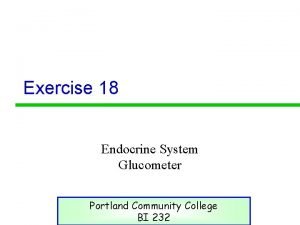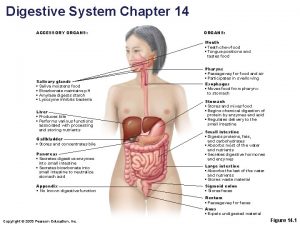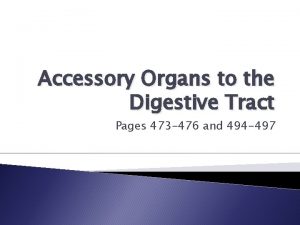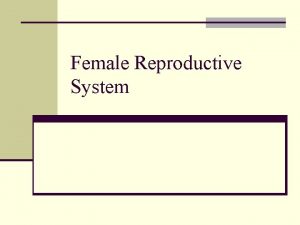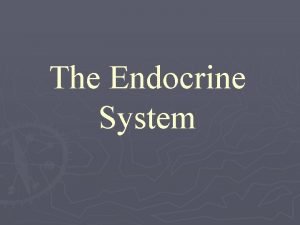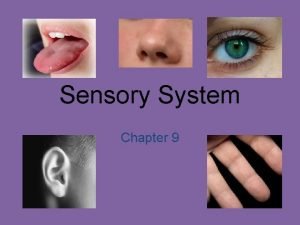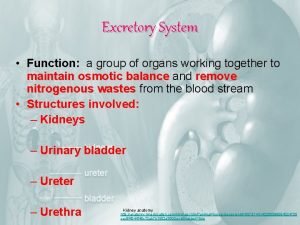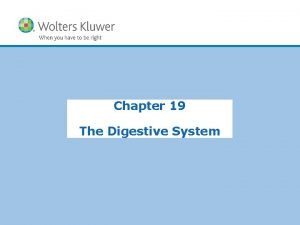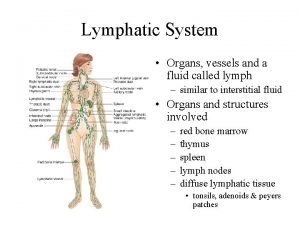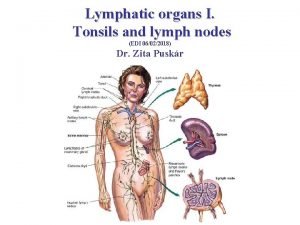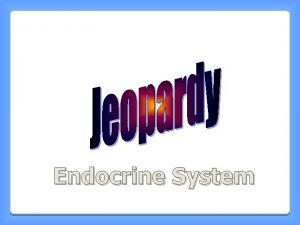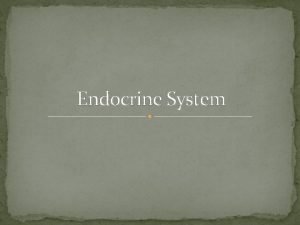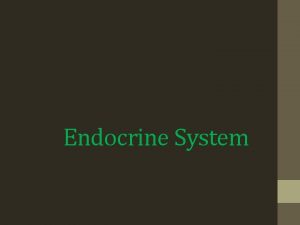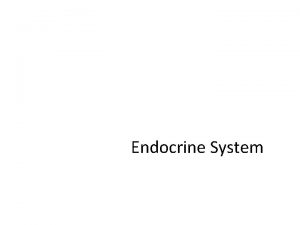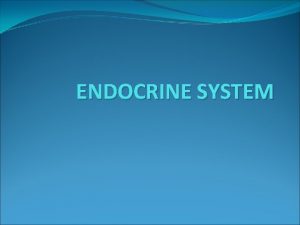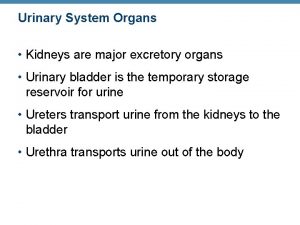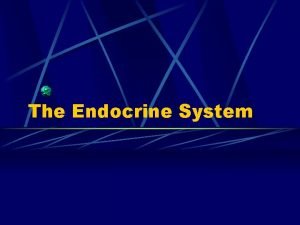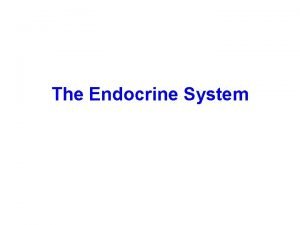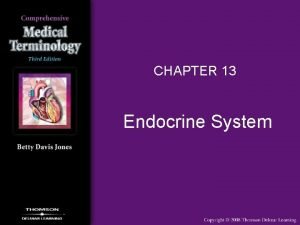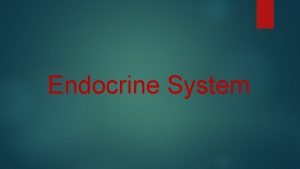Endocrine System part 4 The Major Endocrine Organs


















- Slides: 18

Endocrine System part 4

The Major Endocrine Organs • Hypothalamus • Pituitary gland • Pineal gland • Thyroid gland • Parathyroid glands • Thymus • Adrenal glands • Pancreas • Gonads (testes and ovaries) © 2018 Pearson Education, Inc.

Figure 9. 3 Location of the major endocrine organs of the. Thyroid body. gland Pineal gland Hypothalamus Pituitary gland Parathyroid glands Thymus Adrenal glands Pancreas Ovary (female) Testis (male)

The Major Endocrine Organs • Some glands have purely endocrine functions • Anterior pituitary, thyroid, adrenals, parathyroids • Endocrine glands are ductless glands • Hormones are released directly into blood or lymph • Other glands are mixed glands, with both endocrine and exocrine functions (pancreas, gonads) © 2018 Pearson Education, Inc.

Pituitary Gland Hypothalamus • Pituitary gland • Pea-sized gland that hangs by a stalk from the hypothalamus in the brain • Protected by the sella turcica of the sphenoid bone • Has two functional lobes • Anterior pituitary—glandular tissue • Posterior pituitary—nervous tissue • Often called the “master endocrine gland” © 2018 Pearson Education, Inc.

Pituitary Gland Hypothalamus • Hypothalamus produces releasing hormones and inhibiting hormones • These hormones are released into portal circulation, which connects hypothalamus to anterior pituitary • Hypothalamus also makes two hormones: oxytocin and antidiuretic hormone • Carried to posterior pituitary via neurosecretory cells for storage © 2018 Pearson Education, Inc.

Hypothalamic neurosecretory cells Hypothalamus Figure 9. 4 Hormones released by the posterior pituitary and their target organs. Optic chiasma Axon terminals Arterial blood supply Posterior lobe Capillary bed Venous drainage Anterior lobe of the pituitary ADH Oxytocin Kidney tubules Mammary glands Uterine muscles

Pituitary Gland Hypothalamus • Posterior pituitary • Does not make the hormones it releases • Stores hormones made by the hypothalamus • Two hormones released • Oxytocin • Antidiuretic hormone (ADH) © 2018 Pearson Education, Inc.

Pituitary Gland Hypothalamus • Posterior pituitary (continued) • Oxytocin • Stimulates contractions of the uterus during labor, sexual relations, and breastfeeding • Causes milk ejection (let-down reflex) in a breastfeeding woman © 2018 Pearson Education, Inc.

Pituitary Gland Hypothalamus • Posterior pituitary (continued) • Antidiuretic hormone (ADH) • Inhibits urine production (diuresis) by promoting water reabsorption by the kidneys • Urine volume decreases, blood pressure increases • In large amounts, causes constriction of arterioles, leading to increased blood pressure (the reason why ADH is known as vasopressin) • Alcohol inhibits ADH secretion © 2018 Pearson Education, Inc.

Hypothalamic neurosecretory cells Hypothalamus Figure 9. 4 Hormones released by the posterior pituitary and their target organs. Optic chiasma Axon terminals Arterial blood supply Posterior lobe Capillary bed Venous drainage Anterior lobe of the pituitary ADH Oxytocin Kidney tubules Mammary glands Uterine muscles

Pituitary Gland Hypothalamus • Six anterior pituitary hormones • Two hormones affect nonendocrine targets 1. Growth hormone 2. Prolactin • Four are tropic hormones 1. 2. 3. 4. Follicle-stimulating hormone Luteinizing hormone Thyrotropic hormone Adrenocorticotropic hormone © 2018 Pearson Education, Inc.

Figure 9. 5 Hormones of the anterior pituitary and their major target organs. Releasing hormones secreted into portal circulation Hypothalamus Anterior pituitary Posterior pituitary Hypophyseal portal system Adrenocorticotropic hormone (ACTH) Growth hormone (GH) Bones and muscles Prolactin (PRL) Follicle-stimulating Thyrotropic hormone (TH) hormone (FSH) and luteinizing Mammary hormone (LH) glands Thyroid Testes or ovaries Adrenal cortex

Pituitary Gland Hypothalamus • All anterior pituitary hormones: • • Are proteins (or peptides) Act through second-messenger systems Are regulated by hormonal stimuli Are regulated mostly by negative feedback © 2018 Pearson Education, Inc.

Pituitary Gland Hypothalamus • Growth hormone (GH) • • • General metabolic hormone Major effects are directed to growth of skeletal muscles and long bones Plays a role in determining final body size Causes amino acids to be built into proteins Causes fats to be broken down for a source of energy © 2018 Pearson Education, Inc.

Pituitary Gland Hypothalamus • Prolactin (PRL) • Stimulates and maintains milk production following childbirth • Function in males is unknown © 2018 Pearson Education, Inc.

Pituitary Gland Hypothalamus • Gonadotropic hormones • Regulate hormonal activity of the gonads • Follicle-stimulating hormone (FSH) • Stimulates follicle development in ovaries • Stimulates sperm development in testes • Luteinizing hormone (LH) • Triggers ovulation of an egg in females • Stimulates testosterone production in males © 2018 Pearson Education, Inc.

Pituitary Gland Hypothalamus • Thyrotropic hormone (TH), also called thyroid-stimulating hormone (TSH) • Influences growth and activity of the thyroid gland • Adrenocorticotropic hormone (ACTH) • Regulates endocrine activity of the adrenal cortex © 2018 Pearson Education, Inc.
 Chapter 16 matching question 6-10
Chapter 16 matching question 6-10 Endocrine organs
Endocrine organs Accessory organ of the digestive system
Accessory organ of the digestive system Major and accessory organs of the digestive system
Major and accessory organs of the digestive system Main function of major organs
Main function of major organs Major plant organs
Major plant organs Major endocrine glands male and female
Major endocrine glands male and female Endocrine system and reproductive system
Endocrine system and reproductive system Endocrine system and nervous system
Endocrine system and nervous system Lymphatic system vs endocrine system
Lymphatic system vs endocrine system Mechanism of hormone action
Mechanism of hormone action Adh function
Adh function Sensory system organs
Sensory system organs Excretory system function
Excretory system function Accessory organs of the digestive system
Accessory organs of the digestive system Spleen function
Spleen function Formation of lymph
Formation of lymph Tonsils
Tonsils Lymphatic system organs and functions
Lymphatic system organs and functions

